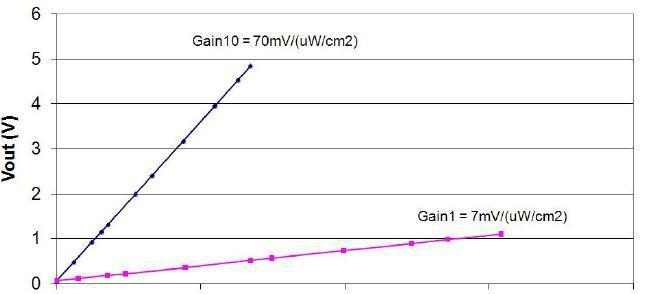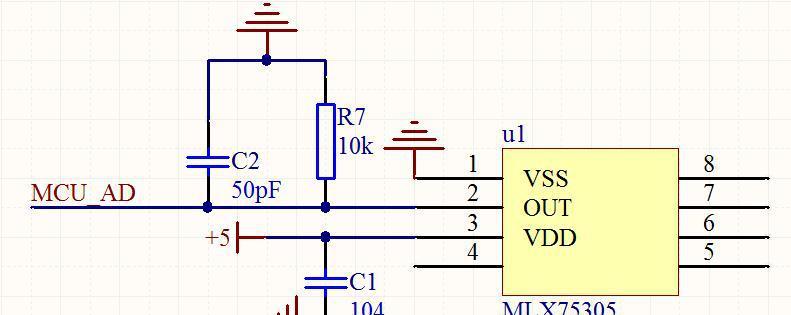基于MLX75305车载LCD背光触发机制的典型方案
 364
364
 拍明
拍明
汽车进入隧道时候,需要打开照明或者自动点亮LCD屏的背光。这就需求对自然光强度的变化进行检测。MLX75305适用于测量环境亮度或用于控制LCD背光亮度应用的LED亮度。
传统的光照传感器主要采用光敏电阻,光敏电阻的光电流与光照度之间的关系称为光电特性。光敏电阻的光电特性呈非线性,因此不适宜作检测元件,在自动控制中它常被用作开关式光电传感器。光敏电阻需要用A/D转换器将其信号转换为数字信号,电路复杂,费用高。而且,光敏电阻进行光强度采集不够理想。
针对光敏电阻的诸多缺点,提出了一种高精度数字光强度传感器MLX75305进行光强度的设计方案,利用模拟输出光强度传感器,可支持较大范围的光照强度变化。
MLX75305光-电压转换SensorEyeC是一款简单易用的光传感器,把光强度转换成输出电压。MLX75305超出同类产品,高度线性响应,在强光条件下能够快速转换, 具备低的温度可靠性强,小型封装 DFN3x3,电源电压 3V或者5.5V。可以应用在周围光强检测,LCD屏背光调节和 LED光学控制等场合。
MLX75305遵循RoHS,并且适合260°C的回流焊接。针对汽车应用并且拥有AEC-Q100 认证,高达125°C 工作温度。

图1:MLX75305传感器的输出电压随入射光线性变化而变化
MLX75305传感器的输出电压随入射光线性变化而变化。MLX75305是一款集成的传感器IC,这意味着光敏二极管、跨阻放大器以及线性电压输出阶都包括到了传感芯片中。这保证了所有时间和温度下稳定的光敏感度,而且与使用数字光敏二极管的设计相比极大的改善了噪声特性。器件简化了应用设计,需要更少的外部器件并改善了质量。
MLX75305是设计很简单,只需要2个电容和一个电阻即可,并且输出电压幅值较大,便于MCU做AD处理。

图2:MLX75305设计电路
MLX75305传感器是迈来芯公司自主研发的光传感器的第二个成员,为高容量汽车、工业和消费电子应用所设计,它能充分体现了光电传感器的输出电压值随入射光线强度变化而变化的本质特性。
车载显示器分有两种一种是放置在客车上面观看的电视,实质上就是车载电视,另一种是小尺寸车载显示器有3.5寸、 4.3寸、7寸和9寸的,一般有两路视频输入,一路可以接车载DVD用,另一路接倒车影像车载摄像头用,有的还带有MP5视频播放和蓝牙功能,能够在汽车同类运动工具上使用的显示器,方便在汽车运动中使用。车载电视简单地说就是数字电视的移动接收(和数字电视的区别),主要包括机顶盒、液晶显示屏、天线、车载电源等。为了方便安装使用,已经开发出了诸如台式车载电视、挡板式车载电视和顶吸式车载电视、后视镜显示器等多种款式的车载移动电视产品。
车载显示器主要用途有如加上车载摄像头用于倒车或用于公交,地铁 火车等上面进行广告的宣传等,现在只要市场上的主流产品有带电视,带外音,可读SD卡,USB等功能。有部分产品就沿着车载电脑显示器的方向发展,
未来的车载显示器会跟更多的跨时代的科技联系,就如3D,也许有一天我们就会把3D技术带来的精彩搬进我们的爱车。
车载显示设备通常是液晶显示屏,带外音,可读SD卡,USB和蓝牙等功能。车载领航员的车载显示器有来电语音报号功能,这是因为液晶屏的体积比较小,便于安装,可以安装到仪表盘附近、车顶、座椅靠背后,甚至安装在遮阳板上,方便在各种情况下使用。此外,车载显示设备往往还集成了其他功能,比如带有简单的功放、电视接收功能、音频输出等,种类和功能比电视或者计算机显示器更繁多。
TFT液晶显示器成为主流
根据预测,TFT液晶显示器凭借其高性能比和低成本化,造成汽车配置液晶面板的比率大幅增长,将成为车载用的影音系统和车载用导航系统显示器的主流。不过由于播放的内容持续丰富,使得车载液晶面板的规格也日渐增加,例如高精细化显示品质、高亮度、大尺寸化、广视角化、薄型化、轻量化、高可靠度、低耗电等等。比如,为了让用户在驾驶汽车的时候一目了然,提供更高清晰度,高画质的画面必然成为发展趋势。
今后,车载显示器的分辨率为800×400以及更高,屏幕也会一定范围内扩大。从而,避免在驾驶过程中因屏幕较小而过分集中观看屏幕的尴尬。更进一步的,单一屏幕双显示功能的LCD面板也已经被业者开发出来,如此一来,就能以单一显示面板,同时提供驾驶座及副驾驶座不同的影像信息,驾驶人可以观看导航画面、而副驾驶座乘客则可观看影像节目或其它信息、资料。两个显示设备可以分别独立调整屏幕更新率、分辨率和色彩深度,而且能够支持各个不同应用。
触控面板步入市场
触控面板可以提供使用者更便利性的操作接口,这比起过去在副驾驶座上利用遥控器来操作车载用导航系统来显得更为便利。在未来的车载显示器市场必将得到发展。
车载显示器 一般分为几款式
后视镜显示器.遮阳板显示器/车载支架显示器 折叠显示器
显示器使用也有不同操作
触摸屏:一般价格都是比较贵
按键或者遥控控制 这类比较多 性价比也比较好
Mobileye, an Intel company, was launched in 1999 with the belief that vision-safety technology will make our roads safer, reduce traffic congestion and save lives. With a cutting edge team of more than 450 engineers, Mobileye has developed a range of software products that is deployed on a proprietary family of computer chips named EyeQ®.
Mobileye is the leading supplier of software that enables Advanced Driver Assist Systems (ADAS), with more than 25 automaker partners including some of the world’s largest. Beyond ADAS, our technology has rapidly evolved to also support the three pillars of Autonomous Driving – Sensing, Mapping, and Driving Policy. As a result of this broad and well-advanced product offering, we have achieved a partnership to develop production-ready Fully Autonomous Vehicles with BMW and Intel, with production launch planned for 2021, and another partnership with the Tier-1 supplier Delphi for a “turnkey” system to be productized starting from 2019 with customer OEMs.
We are dedicated to continuing our 17 year tradition of leveraging the newest technology, including AI, deep learning and crowdsourcing, to create the hardware and software needed to help our 27 OEM partners enable ADAS systems and eventually fully autonomous vehicles. These partners choose Mobileye due to our track-record of innovation, but also because our systems have been validated to the highest level of safety and accuracy over millions of miles.
Inspired by Human Vision
Mobileye’s strength comes in part from our early realization that a single-lensed camera (mono-camera) would become the primary sensor to support Advanced Driver Assistance Systems (ADAS) and eventually Autonomous Vehicles. The mono-camera is the most versatile of sensing technologies, with the ability to identify shapes, like vehicles and pedestrians, as well as textures, like lane markings and traffic-sign text. This realization marked a revolutionary leap in the market, as sensors like dual-lensed cameras (stereo-vision) and radar were previously regarded as superior. Today, most global automakers have chosen mono-vision as the primary information source for Advanced Driver Assistance Systems, and Mobileye continues to lead innovation in the field.
“The Mobileye mono-camera was inspired by human vision, which only uses both eyes to obtain depth perception for very short distances,” says Amnon Shashua, co-founder, chairman and CTO of Mobileye. “Therefore, the added benefit of a second camera lens is only relevant for short distances. Driving-scene interpretation is based on much longer distances. All depth-perception cues for farther distances – such as perspective, shading, texture, and motion cues, that the human visual system uses in order to understand the visual world – are interpreted by a single eye. Therefore, Mobileye understood that a single-lens camera could be the primary sensor to enable autonomous driving.”
Mobileye’s vision safety technology for ADAS is deployed on over 25 million vehicles and counting, making today’s roadways safer for all. We work closely with global automakers to continuously deploy advancements in safety and convenience. Over the next several years, as more stringent safety regulations are implemented in major markets, it is expected that the percentage of newly-produced vehicles that include ADAS will increase.
Building on ADAS products like Automatic Emergency Braking and Lane Keeping Assistance, that form the building blocks for higher level autonomous vehicles, Mobileye is now using the latest techniques in Artificial Intelligence and deep learning to deploy 360-degree surround-view mono-vision sensing; to build high-definition, crowdsourced maps; and to provide vehicles with the computer intelligence required to negotiate complex driving situations. We believe that these technologies, along with important technological inputs developed by our automaker and supplier partners, can eventually result in a world where vehicle injuries and fatalities can be reduced by a very significant amount.
Mobileye was listed on the New York Stock Exchange in 2014 following the largest-ever IPO of an Israeli company in the United States. Mobileye has won many awards. Most recently, MIT Technology Review ranked Mobileye #6 Smartest Company in 2016.
In 2017, Intel Corporation acquired Mobileye. Together, Intel and Mobileye will make autonomous driving a reality. We have the collective depth and breadth of experience, talent, technology, and resources to deliver safe and scalable AV solutions.
To view Mobileye’s ISO 9001 certificate, please click here.
责任编辑:Davia
【免责声明】
1、本文内容、数据、图表等来源于网络引用或其他公开资料,版权归属原作者、原发表出处。若版权所有方对本文的引用持有异议,请联系拍明芯城(marketing@iczoom.com),本方将及时处理。
2、本文的引用仅供读者交流学习使用,不涉及商业目的。
3、本文内容仅代表作者观点,拍明芯城不对内容的准确性、可靠性或完整性提供明示或暗示的保证。读者阅读本文后做出的决定或行为,是基于自主意愿和独立判断做出的,请读者明确相关结果。
4、如需转载本方拥有版权的文章,请联系拍明芯城(marketing@iczoom.com)注明“转载原因”。未经允许私自转载拍明芯城将保留追究其法律责任的权利。
拍明芯城拥有对此声明的最终解释权。




 产品分类
产品分类















 2012- 2022 拍明芯城ICZOOM.com 版权所有 客服热线:400-693-8369 (9:00-18:00)
2012- 2022 拍明芯城ICZOOM.com 版权所有 客服热线:400-693-8369 (9:00-18:00)


